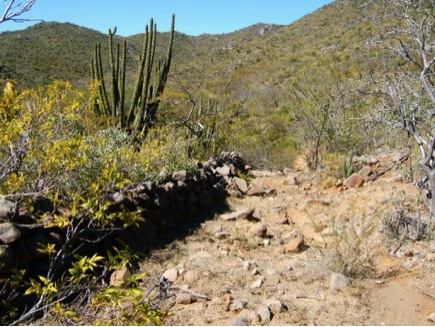
By David Kier
www.vivabaja.com
Co-author of ‘The Old Missions of Baja & Alta California, 1697-1834’
The seventh California mission was founded by two Jesuit padres: Jaime Bravo and Juan de Ugarte. The site was near the shore of La Paz Bay and locally known as Airapí. The journey to La Paz began at Loreto on the Jesuit ship ‘El Triunfo de la Cruz’ built in Mulegé from lumber cut in the mountains to the west. Padres Bravo and Ugarte were joined by Padre Clemente Guillén from the mission at Malibat (Ligüí), who came by land with soldiers and neophytes.
La Paz was unique as no one Indian group lived there; instead it was visited by several peninsula tribes of Guaycuras, and Pericús who came from the islands off shore. These various groups often were at war with each other. Padre Jaime Bravo would remain at La Paz until 1728, but always with 4-12 soldiers for protection. Padre Guillermo Gordon replaced Bravo for the next 5 years.
Visitas are visiting stations or satellites of the head mission. Most missions had several visitas. One such visita of Mission Pilar de la Paz was named Angel de la Guarda. It was established in 1721 by Padre Bravo about 20 miles south, on a mountain top oasis. At the western foot of the same mountain is a church ruin called El Novillo, it was sometimes shown on maps as a mission. In 1725, Padre Bravo established another visita of La Paz about 50 miles to the south and close to the Pacific coast. Bravo never recorded an Indian name for the location, but he called it Todos Santos. This visita was so productive that it became a separate mission in 1733 with the name Santa Rosa de las Palmas.
In October of 1734, after months of unrest, the various tribes in the cape region rebelled and murdered Padre Nicolás Tamaral at San José del Cabo. Mission Santiago’s Padre Lorenzo Carranco was also killed, along with his two servants. At La Paz, a soldier who was guarding the vacant mission was killed. Padre Sigismundo Taraval of the Santa Rosa mission was saved by his soldiers who dragged him away just before the natives began to attack.
Following the rebellion was two more years of vacancy at La Paz. The Jesuit padres from both the Santa Rosa and San Luis Gonzaga missions would visit La Paz between 1737 and 1748. In 1748, the mission was moved to Todos Santos, replacing the younger Santa Rosa mission already there. Officially the mission name remained Nuestra Señora del Pilar de la Paz, but it was nearly always called Todos Santos after the move.
When the Franciscans replaced the Jesuits in 1768, the population of neophytes was reported to be about 90. An adobe church measuring 67 feet by 25 feet was built in 1786 by the Dominicans. The native population had doubled to 181 in 1800. The mission remained at the same location until 1825 when it was moved a mile south, where the church is today, in the town plaza.
The original Todos Santos mission site has since become a car repair business (using some of the mission walls), along with a church built in 1970. The 1825 mission site is the downtown church, where newer construction was added to older walls and foundations. Mission functions ceased about 1840, but church services continued on for the newer population arriving from the mainland of Mexico.
No remains of the original Pilar de la Paz mission at La Paz Bay are known to exist, however a plaque on a La Paz city side street marks a possible location. The modern church in La Paz is sometimes called the mission site, but it is 3 blocks to the north and one block east from the plaque. Some local historians believe the mission was even a little further south where old sketches showed palms growing.




